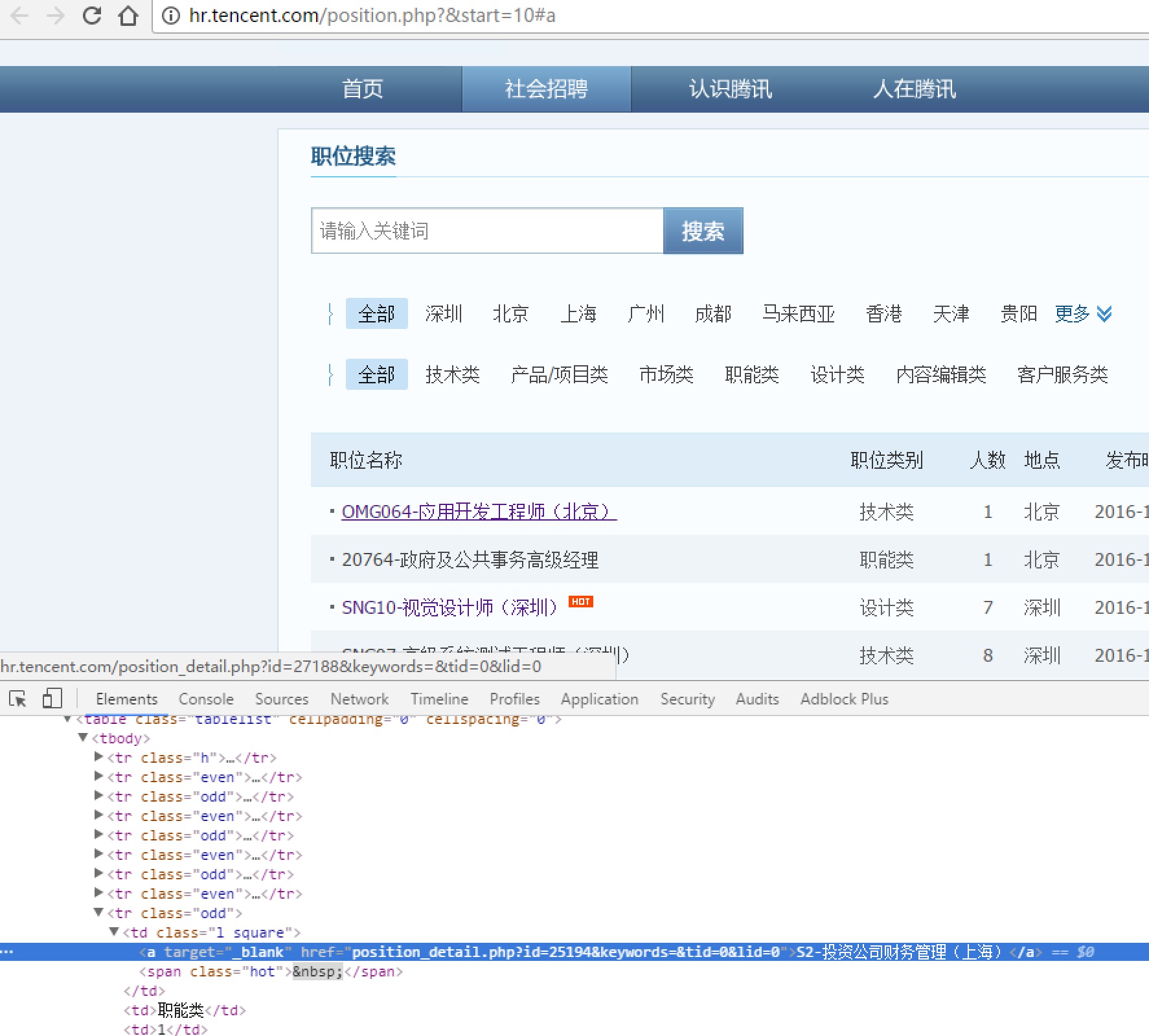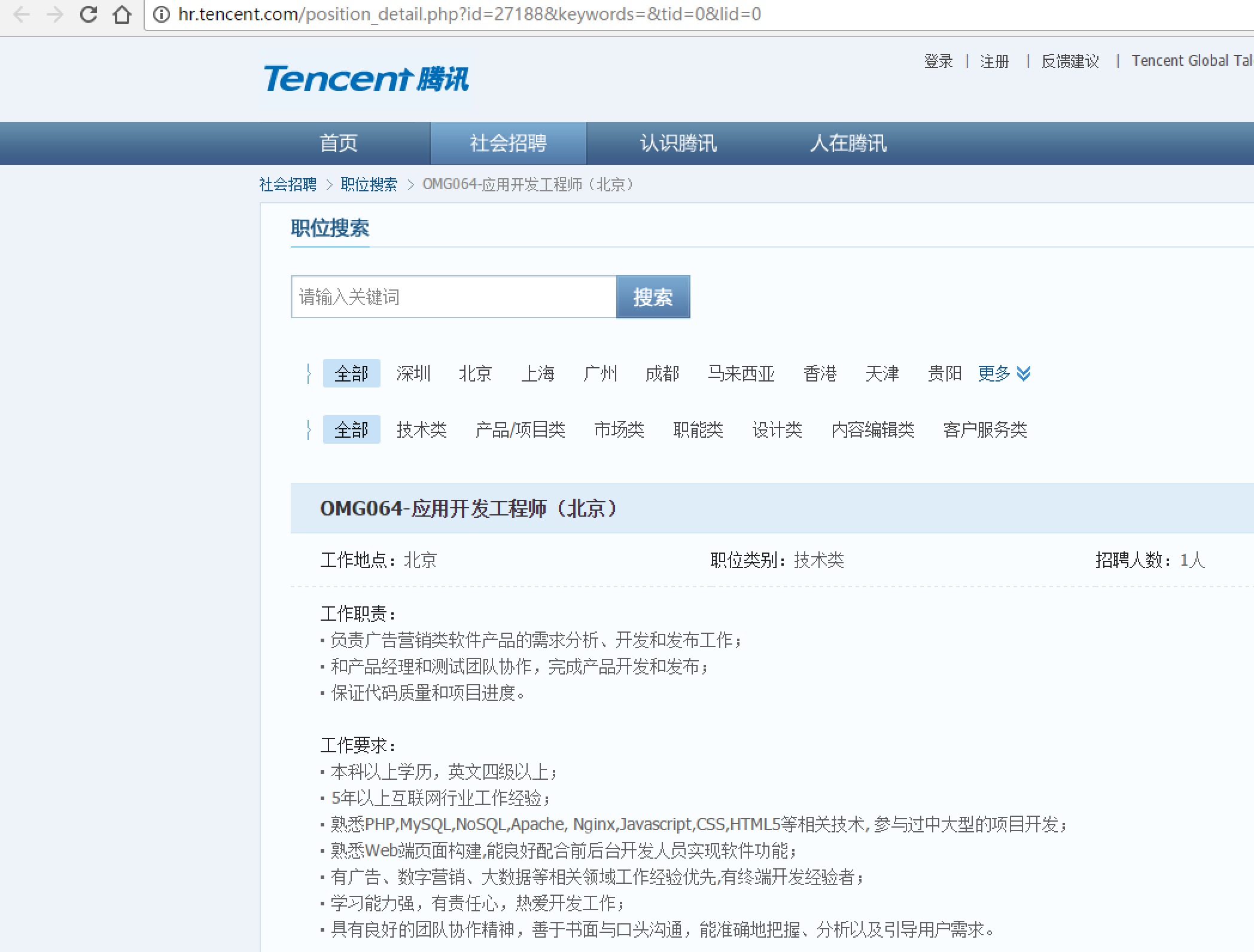六、CSS 选择器:BeautifulSoup4
和 lxml 一样,Beautiful Soup 也是一个HTML/XML的解析器,主要的功能也是如何解析和提取 HTML/XML 数据。
lxml 只会局部遍历,而Beautiful Soup 是基于HTML DOM的,会载入整个文档,解析整个DOM树,因此时间和内存开销都会大很多,所以性能要低于lxml。
BeautifulSoup 用来解析 HTML 比较简单,API非常人性化,支持CSS选择器、Python标准库中的HTML解析器,也支持 lxml 的 XML解析器。
Beautiful Soup 3 目前已经停止开发,推荐现在的项目使用Beautiful Soup 4。使用 pip 安装即可:
pip install beautifulsoup4
| 抓取工具 | 速度 | 使用难度 | 安装难度 |
|---|---|---|---|
| 正则 | 最快 | 困难 | 无(内置) |
| BeautifulSoup | 慢 | 最简单 | 简单 |
| lxml | 快 | 简单 | 一般 |
示例:
首先必须要导入 bs4 库
# beautifulsoup4_test.py
from bs4 import BeautifulSoup
html = """
<html><head><title>The Dormouse's story</title></head>
<body>
<p class="title" name="dromouse"><b>The Dormouse's story</b></p>
<p class="story">Once upon a time there were three little sisters; and their names were
<a href="http://example.com/elsie" class="sister" id="link1"><!-- Elsie --></a>,
<a href="http://example.com/lacie" class="sister" id="link2">Lacie</a> and
<a href="http://example.com/tillie" class="sister" id="link3">Tillie</a>;
and they lived at the bottom of a well.</p>
<p class="story">...</p>
"""
#创建 Beautiful Soup 对象
soup = BeautifulSoup(html)
#打开本地 HTML 文件的方式来创建对象
#soup = BeautifulSoup(open('index.html'))
#格式化输出 soup 对象的内容
print soup.prettify()
运行结果:
<html>
<head>
<title>
The Dormouse's story
</title>
</head>
<body>
<p class="title" name="dromouse">
<b>
The Dormouse's story
</b>
</p>
<p class="story">
Once upon a time there were three little sisters; and their names were
<a class="sister" href="http://example.com/elsie" id="link1">
<!-- Elsie -->
</a>
,
<a class="sister" href="http://example.com/lacie" id="link2">
Lacie
</a>
and
<a class="sister" href="http://example.com/tillie" id="link3">
Tillie
</a>
;
and they lived at the bottom of a well.
</p>
<p class="story">
...
</p>
</body>
</html>
如果我们在 IPython2 下执行,会看到这样一段警告:

-
意思是,如果我们没有显式地指定解析器,所以默认使用这个系统的最佳可用HTML解析器(“lxml”)。如果你在另一个系统中运行这段代码,或者在不同的虚拟环境中,使用不同的解析器造成行为不同。
- 但是我们可以通过
soup = BeautifulSoup(html,“lxml”)方式指定lxml解析器。
四大对象种类
Beautiful Soup将复杂HTML文档转换成一个复杂的树形结构,每个节点都是Python对象,所有对象可以归纳为4种:
- Tag
- NavigableString
- BeautifulSoup
- Comment
1. Tag
Tag 通俗点讲就是 HTML 中的一个个标签,例如:
<head><title>The Dormouse's story</title></head> <a class="sister" href="http://example.com/elsie" id="link1"><!-- Elsie --></a> <p class="title" name="dromouse"><b>The Dormouse's story</b></p>
上面的 title head a p等等 HTML 标签加上里面包括的内容就是 Tag,那么试着使用 Beautiful Soup 来获取 Tags:
from bs4 import BeautifulSoup html = """ <html><head><title>The Dormouse's story</title></head> <body> <p class="title" name="dromouse"><b>The Dormouse's story</b></p> <p class="story">Once upon a time there were three little sisters; and their names were <a href="http://example.com/elsie" class="sister" id="link1"><!-- Elsie --></a>, <a href="http://example.com/lacie" class="sister" id="link2">Lacie</a> and <a href="http://example.com/tillie" class="sister" id="link3">Tillie</a>; and they lived at the bottom of a well.</p> <p class="story">...</p> """ #创建 Beautiful Soup 对象 soup = BeautifulSoup(html) print soup.title # <title>The Dormouse's story</title> print soup.head # <head><title>The Dormouse's story</title></head> print soup.a # <a class="sister" href="http://example.com/elsie" id="link1"><!-- Elsie --></a> print soup.p # <p class="title" name="dromouse"><b>The Dormouse's story</b></p> print type(soup.p) # <class 'bs4.element.Tag'>
我们可以利用 soup 加标签名轻松地获取这些标签的内容,这些对象的类型是bs4.element.Tag。但是注意,它查找的是在所有内容中的第一个符合要求的标签。如果要查询所有的标签,后面会进行介绍。
对于 Tag,它有两个重要的属性,是 name 和 attrs
print soup.name
# [document] #soup 对象本身比较特殊,它的 name 即为 [document]
print soup.head.name
# head #对于其他内部标签,输出的值便为标签本身的名称
print soup.p.attrs
# {'class': ['title'], 'name': 'dromouse'}
# 在这里,我们把 p 标签的所有属性打印输出了出来,得到的类型是一个字典。
print soup.p['class'] # soup.p.get('class')
# ['title'] #还可以利用get方法,传入属性的名称,二者是等价的
soup.p['class'] = "newClass"
print soup.p # 可以对这些属性和内容等等进行修改
# <p class="newClass" name="dromouse"><b>The Dormouse's story</b></p>
del soup.p['class'] # 还可以对这个属性进行删除
print soup.p
# <p name="dromouse"><b>The Dormouse's story</b></p>
2. NavigableString
既然我们已经得到了标签的内容,那么问题来了,我们要想获取标签内部的文字怎么办呢?很简单,用 .string 即可,例如
print soup.p.string # The Dormouse's story print type(soup.p.string) # In [13]: <class 'bs4.element.NavigableString'>
3. BeautifulSoup
BeautifulSoup 对象表示的是一个文档的内容。大部分时候,可以把它当作 Tag 对象,是一个特殊的 Tag,我们可以分别获取它的类型,名称,以及属性来感受一下
print type(soup.name)
# <type 'unicode'>
print soup.name
# [document]
print soup.attrs # 文档本身的属性为空
# {}
4. Comment
Comment 对象是一个特殊类型的 NavigableString 对象,其输出的内容不包括注释符号。
print soup.a # <a class="sister" href="http://example.com/elsie" id="link1"><!-- Elsie --></a> print soup.a.string # Elsie print type(soup.a.string) # <class 'bs4.element.Comment'>
a 标签里的内容实际上是注释,但是如果我们利用 .string 来输出它的内容时,注释符号已经去掉了。
遍历文档树
1. 直接子节点 :.contents .children 属性
.content
tag 的 .content 属性可以将tag的子节点以列表的方式输出
print soup.head.contents #[<title>The Dormouse's story</title>]
输出方式为列表,我们可以用列表索引来获取它的某一个元素
print soup.head.contents[0] #<title>The Dormouse's story</title>
.children
它返回的不是一个 list,不过我们可以通过遍历获取所有子节点。
我们打印输出 .children 看一下,可以发现它是一个 list 生成器对象
print soup.head.children
#<listiterator object at 0x7f71457f5710>
for child in soup.body.children:
print child
结果:
<p class="title" name="dromouse"><b>The Dormouse's story</b></p> <p class="story">Once upon a time there were three little sisters; and their names were <a class="sister" href="http://example.com/elsie" id="link1"><!-- Elsie --></a>, <a class="sister" href="http://example.com/lacie" id="link2">Lacie</a> and <a class="sister" href="http://example.com/tillie" id="link3">Tillie</a>; and they lived at the bottom of a well.</p> <p class="story">...</p>
2. 所有子孙节点: .descendants 属性
.contents 和 .children 属性仅包含tag的直接子节点,.descendants 属性可以对所有tag的子孙节点进行递归循环,和 children类似,我们也需要遍历获取其中的内容。
for child in soup.descendants:
print child
运行结果:
<html><head><title>The Dormouse's story</title></head> <body> <p class="title" name="dromouse"><b>The Dormouse's story</b></p> <p class="story">Once upon a time there were three little sisters; and their names were <a class="sister" href="http://example.com/elsie" id="link1"><!-- Elsie --></a>, <a class="sister" href="http://example.com/lacie" id="link2">Lacie</a> and <a class="sister" href="http://example.com/tillie" id="link3">Tillie</a>; and they lived at the bottom of a well.</p> <p class="story">...</p> </body></html> <head><title>The Dormouse's story</title></head> <title>The Dormouse's story</title> The Dormouse's story <body> <p class="title" name="dromouse"><b>The Dormouse's story</b></p> <p class="story">Once upon a time there were three little sisters; and their names were <a class="sister" href="http://example.com/elsie" id="link1"><!-- Elsie --></a>, <a class="sister" href="http://example.com/lacie" id="link2">Lacie</a> and <a class="sister" href="http://example.com/tillie" id="link3">Tillie</a>; and they lived at the bottom of a well.</p> <p class="story">...</p> </body> <p class="title" name="dromouse"><b>The Dormouse's story</b></p> <b>The Dormouse's story</b> The Dormouse's story <p class="story">Once upon a time there were three little sisters; and their names were <a class="sister" href="http://example.com/elsie" id="link1"><!-- Elsie --></a>, <a class="sister" href="http://example.com/lacie" id="link2">Lacie</a> and <a class="sister" href="http://example.com/tillie" id="link3">Tillie</a>; and they lived at the bottom of a well.</p> Once upon a time there were three little sisters; and their names were <a class="sister" href="http://example.com/elsie" id="link1"><!-- Elsie --></a> Elsie , <a class="sister" href="http://example.com/lacie" id="link2">Lacie</a> Lacie and <a class="sister" href="http://example.com/tillie" id="link3">Tillie</a> Tillie ; and they lived at the bottom of a well. <p class="story">...</p> ...
3. 节点内容: .string 属性
如果tag只有一个 NavigableString 类型子节点,那么这个tag可以使用 .string 得到子节点。如果一个tag仅有一个子节点,那么这个tag也可以使用 .string 方法,输出结果与当前唯一子节点的 .string 结果相同。
通俗点说就是:如果一个标签里面没有标签了,那么 .string 就会返回标签里面的内容。如果标签里面只有唯一的一个标签了,那么 .string 也会返回最里面的内容。例如:
print soup.head.string #The Dormouse's story print soup.title.string #The Dormouse's story
搜索文档树
1.find_all(name, attrs, recursive, text, **kwargs)
1)name 参数
name 参数可以查找所有名字为 name 的tag,字符串对象会被自动忽略掉
A.传字符串
最简单的过滤器是字符串.在搜索方法中传入一个字符串参数,Beautiful Soup会查找与字符串完整匹配的内容,下面的例子用于查找文档中所有的<b>标签:
soup.find_all('b')
# [<b>The Dormouse's story</b>]
print soup.find_all('a')
#[<a class="sister" href="http://example.com/elsie" id="link1"><!-- Elsie --></a>, <a class="sister" href="http://example.com/lacie" id="link2">Lacie</a>, <a class="sister" href="http://example.com/tillie" id="link3">Tillie</a>]
B.传正则表达式
如果传入正则表达式作为参数,Beautiful Soup会通过正则表达式的 match() 来匹配内容.下面例子中找出所有以b开头的标签,这表示<body>和<b>标签都应该被找到
import re
for tag in soup.find_all(re.compile("^b")):
print(tag.name)
# body
# b
C.传列表
如果传入列表参数,Beautiful Soup会将与列表中任一元素匹配的内容返回.下面代码找到文档中所有<a>标签和<b>标签:
soup.find_all(["a", "b"]) # [<b>The Dormouse's story</b>, # <a class="sister" href="http://example.com/elsie" id="link1">Elsie</a>, # <a class="sister" href="http://example.com/lacie" id="link2">Lacie</a>, # <a class="sister" href="http://example.com/tillie" id="link3">Tillie</a>]
2)keyword 参数
soup.find_all(id='link2') # [<a class="sister" href="http://example.com/lacie" id="link2">Lacie</a>]
3)text 参数
通过 text 参数可以搜搜文档中的字符串内容,与 name 参数的可选值一样, text 参数接受 字符串 , 正则表达式 , 列表
soup.find_all(text="Elsie")
# [u'Elsie']
soup.find_all(text=["Tillie", "Elsie", "Lacie"])
# [u'Elsie', u'Lacie', u'Tillie']
soup.find_all(text=re.compile("Dormouse"))
[u"The Dormouse's story", u"The Dormouse's story"]
CSS选择器
这就是另一种与 find_all 方法有异曲同工之妙的查找方法.
-
写 CSS 时,标签名不加任何修饰,类名前加
.,id名前加# -
在这里我们也可以利用类似的方法来筛选元素,用到的方法是
soup.select(),返回类型是list
(1)通过标签名查找
print soup.select('title')
#[<title>The Dormouse's story</title>]
print soup.select('a')
#[<a class="sister" href="http://example.com/elsie" id="link1"><!-- Elsie --></a>, <a class="sister" href="http://example.com/lacie" id="link2">Lacie</a>, <a class="sister" href="http://example.com/tillie" id="link3">Tillie</a>]
print soup.select('b')
#[<b>The Dormouse's story</b>]
(2)通过类名查找
print soup.select('.sister')
#[<a class="sister" href="http://example.com/elsie" id="link1"><!-- Elsie --></a>, <a class="sister" href="http://example.com/lacie" id="link2">Lacie</a>, <a class="sister" href="http://example.com/tillie" id="link3">Tillie</a>]
(3)通过 id 名查找
print soup.select('#link1')
#[<a class="sister" href="http://example.com/elsie" id="link1"><!-- Elsie --></a>]
(4)组合查找
组合查找即和写 class 文件时,标签名与类名、id名进行的组合原理是一样的,例如查找 p 标签中,id 等于 link1的内容,二者需要用空格分开
print soup.select('p #link1')
#[<a class="sister" href="http://example.com/elsie" id="link1"><!-- Elsie --></a>]
直接子标签查找,则使用 > 分隔
print soup.select("head > title")
#[<title>The Dormouse's story</title>]
(5)属性查找
查找时还可以加入属性元素,属性需要用中括号括起来,注意属性和标签属于同一节点,所以中间不能加空格,否则会无法匹配到。
print soup.select('a[class="sister"]')
#[<a class="sister" href="http://example.com/elsie" id="link1"><!-- Elsie --></a>, <a class="sister" href="http://example.com/lacie" id="link2">Lacie</a>, <a class="sister" href="http://example.com/tillie" id="link3">Tillie</a>]
print soup.select('a[href="http://example.com/elsie"]')
#[<a class="sister" href="http://example.com/elsie" id="link1"><!-- Elsie --></a>]
同样,属性仍然可以与上述查找方式组合,不在同一节点的空格隔开,同一节点的不加空格
print soup.select('p a[href="http://example.com/elsie"]')
#[<a class="sister" href="http://example.com/elsie" id="link1"><!-- Elsie --></a>]
(6) 获取内容
以上的 select 方法返回的结果都是列表形式,可以遍历形式输出,然后用 get_text() 方法来获取它的内容。
soup = BeautifulSoup(html, 'lxml')
print type(soup.select('title'))
print soup.select('title')[0].get_text()
for title in soup.select('title'):
print title.get_text()
案例:使用BeautifuSoup4的爬虫
我们以腾讯社招页面来做演示:http://hr.tencent.com/position.php?&start=10#a

使用BeautifuSoup4解析器,将招聘网页上的职位名称、职位类别、招聘人数、工作地点、发布时间,以及每个职位详情的点击链接存储出来。

# bs4_tencent.py
from bs4 import BeautifulSoup
import urllib2
import urllib
import json # 使用了json格式存储
def tencent():
url = 'http://hr.tencent.com/'
request = urllib2.Request(url + 'position.php?&start=10#a')
response =urllib2.urlopen(request)
resHtml = response.read()
output =open('tencent.json','w')
html = BeautifulSoup(resHtml,'lxml')
# 创建CSS选择器
result = html.select('tr[class="even"]')
result2 = html.select('tr[class="odd"]')
result += result2
items = []
for site in result:
item = {}
name = site.select('td a')[0].get_text()
detailLink = site.select('td a')[0].attrs['href']
catalog = site.select('td')[1].get_text()
recruitNumber = site.select('td')[2].get_text()
workLocation = site.select('td')[3].get_text()
publishTime = site.select('td')[4].get_text()
item['name'] = name
item['detailLink'] = url + detailLink
item['catalog'] = catalog
item['recruitNumber'] = recruitNumber
item['publishTime'] = publishTime
items.append(item)
# 禁用ascii编码,按utf-8编码
line = json.dumps(items,ensure_ascii=False)
output.write(line.encode('utf-8'))
output.close()
if __name__ == "__main__":
tencent()



 浙公网安备 33010602011771号
浙公网安备 33010602011771号